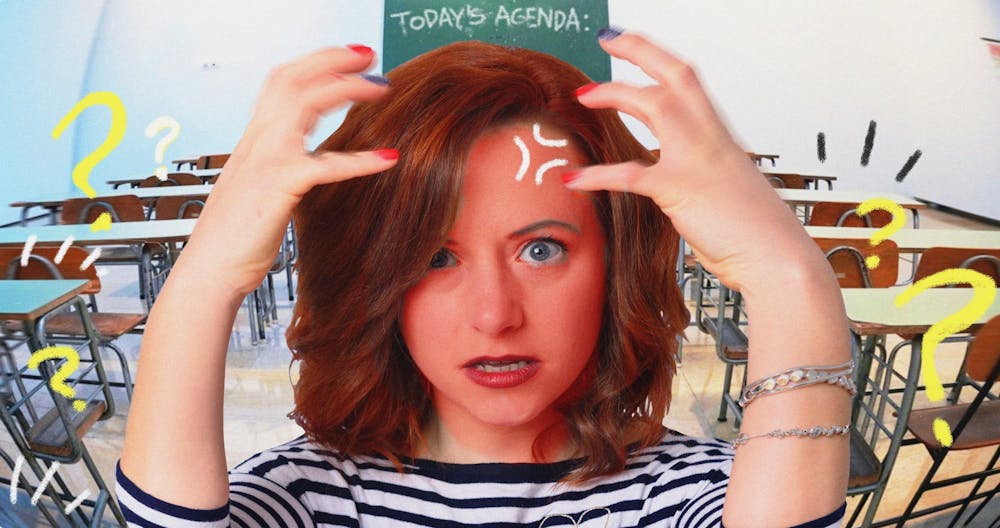By the time Taylor Thornburg’s chemistry class wrapped up on April 29, the few students left were ready to be done.
Thornburg, a first-year kinesiology and premedical studies double major, said the 100-student lecture course saw attendance of just 30.
“For some classes that I’m in, you can not attend lectures and still excel in the course,” Thornburg said. “I’d say that’s one of the main reasons that people don’t come.”
Kimberly Moore, dean of students at Miami University, said many people have told her about problems with attendance this semester.
“I’m hearing from students who are seeing that many of their peers aren’t showing up to exams or coming to class,” Moore said. “I’m hearing from faculty that they’re seeing more disengagement from students.”
Callie Maddox, an assistant professor in the department of sport leadership and management, said the drop in her class attendance started occurring recently.
“Everybody started off strong early on this semester,” Maddox said, “but I’ve noticed in the past two to three weeks that there’s definitely been a fall in attendance.”
Moore attributed some of this problem to the intensity of the COVID-19 pandemic, which has led to burnout and caused students to lose the energy and resilience to finish the semester strong.
“Students are finding that they don’t have the reserves because they’ve spent them managing their way through a pandemic,” Moore said.
The attendance and disengagement problem goes beyond the boundaries of Miami.
The Chronicle of Higher Education reported high levels of student disconnection following the height of the pandemic. Faculty members in a Chronicle survey described this year’s students as “defeated,” “exhausted” and “overwhelmed.”
From responses from the Dean’s Advisory Board (DAB), Moore gathered that online learning has created a divide between attendance and engagement.
Enjoy what you're reading?
Signup for our newsletter
“For the two plus years during the pandemic … [students] were expected to engage virtually,” Moore said. “But it never mattered if they turned their screens on. Nobody cared if they really showed up.”
Some professors have continued posting lectures online, even for in-person classes. Jules Jefferson, a sophomore biochemistry and nutrition double major, said students may be using these online lectures as a replacement for in-person classes.
“Even though [online lectures are] a great way for students to have another accessible way to view the lecture,” Jefferson said, “I feel like students do think that can replace in-person classes.”
As a member-at-large of DAB, Thornburg has been involved in conversations about a solution to student disengagement. One idea was transitioning from lecture-based classes to interactive learning experiences.
“We’ve talked about how students’ experiences should incorporate more interactive experiences in the classroom,” Thornburg said. “ … Whether that’s hands-on learning instead of just a strict lecture-based setup, then that would be beneficial.”
Jefferson has seen professors take different approaches to enforce attendance, from offering extra credit to punishing students who miss class by docking points off their grades.
As an instructor, Maddox said she had a fairly flexible attendance policy and neither adopted nor recommended any disciplinary actions for missing classes.
“I do keep track. I do notice when students don’t show up for class, and I will check in with them,” Maddox said. “But from my personal standpoint, it’s more about encouraging attendance to get the most out of the class.”
Moore said Miami staff and faculty have been actively reaching out to students who have been missing classes, but she would encourage students to actively seek help when in need.
Beyond reaching out to professors for help, students have access to the Rinella Learning Center, the Student Success Center and the Howe Center for Writing Excellence. For many students, though, Moore said help-seeking behaviors in students are dwindling, so reaching out to staff and faculty they regularly interact with can be an easier way to start looking for assistance.
“It does take some self-efficacy on a student’s part to seek out those resources,” Moore said. “But if a student doesn’t know where to go, they can always ask their faculty … they can always go to the people they regularly engage with.”
This fall, Moore said the university will gather statistics indicative of class engagement, such as term gaps and course completion, and develop initiatives to help Miami adapt to the changing needs of students.




